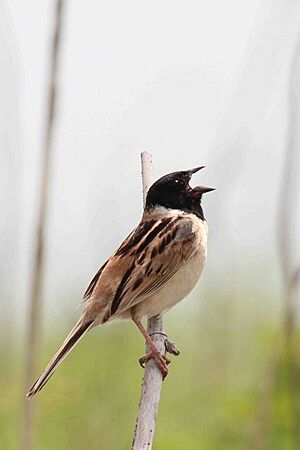Ochre-rumped bunting facts for kids
Quick facts for kids Ochre-rumped bunting |
|
|---|---|
 |
|
| Conservation status | |
| Scientific classification | |
| Synonyms | |
|
The ochre-rumped bunting (Emberiza yessoensis), also called the Japanese reed bunting, is a small bird. It is part of the Emberizidae family. A scientist named Robert Swinhoe first described this bird in 1863.
This bird lives in Manchuria, Korea, and Japan. It likes to live in places with lots of grass and wet areas like swamps. Sadly, its home is shrinking, which is a problem for the bird.
Contents
About the Ochre-rumped Bunting
Bird Family and Relatives
The bird family Emberizidae has about 300 types of birds. Most of these birds eat seeds. While many live in the Americas, the Emberiza group, which has over 40 members, lives in the "Old World" (Europe, Asia, and Africa).
The ochre-rumped bunting is closely related to the common reed bunting and the Pallas's reed bunting. Sometimes, these birds are even put into a different group called Schoeniclus.
Types of Ochre-rumped Buntings
There are two main types, or subspecies, of the ochre-rumped bunting:
- E. y. continentalis: This type breeds in eastern Mongolia, northeast China, and Ussuriland. It spends its winters in eastern China.
- E. y. yessoensis: This type breeds and spends its winters in Japan. It also travels to Korea for the winter.
What Does the Ochre-rumped Bunting Look Like?
This bird is about 15 cm (about 6 inches) long. It often has the brightest colors among the reed buntings. Its legs and beak can look quite pink, especially in winter.
- Male birds: They have a dark back. Their upper parts are a chestnut color, with black and buff stripes on their chest and sides. The back of their neck is brown, but the sides of their neck are whitish.
- Female birds: They have buff-colored areas below their mustache-like stripes and on their throat. They also have black stripes on their cheeks. Their crown (top of the head) is dark brown with pale streaks.
- Young birds (juveniles): They have a pale grayish-brown stripe in the middle of their crown. Their rump (the area above their tail) is yellowish-brown.
What Does It Sound Like?
The call of the ochre-rumped bunting sounds like 'sur-swee-ik' or 'tik'.
Where Does It Live?
This bird prefers open fields that are close to water.


